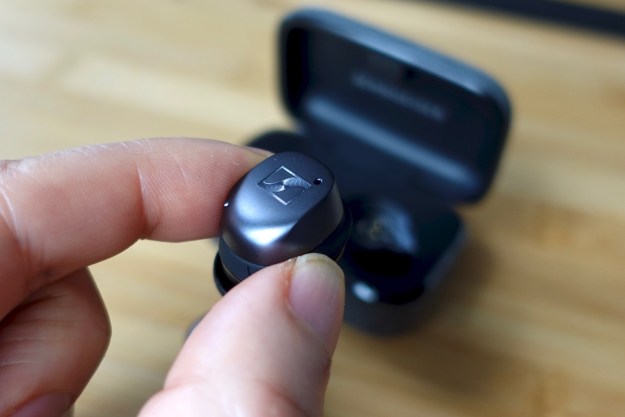
“Sennheiser brings the noise and keeps the peace with the Flex 5000”
- Works with virtually any TV
- Compatible with any wired headphones
- Simple setup and maintenance
- Steady and stable performance
- Cable clip reduces clutter
- Balance profiles can’t be set from receiver
- More affordable alternatives available
- Potential for interference with cordless phones and microwaves
Most home theater setups are about enveloping viewers with big sound that might even rock the house a little, but what about the late night binges and gaming marathons? When volume has no way to ramp up without upsetting someone’s slumber, headphones may be the only recourse.
This is exactly what Sennheiser envisioned with its new Flex 5000, a wireless system allowing viewers to use their own headphones wirelessly, while benefitting from clear and well-synced sound. We wrapped our ears away from the outside world late into the night to see if we could be mesmerized.
Out of the box
The Flex 5000 is really a two-part system made up of a transmitter and a smaller dongle receiver. They’re boxed together with a 3.5mm aux cable, a digital Optical cable, a pair of Sennheiser earbuds, and the power adapter. Attachable power adapters for Europe, the U.K., and Australia are also in the box, along with a quick start guide and full instruction manual.
Features and setup
The Flex 5000 may look a little odd when you’re wearing it, but this is a system built for utility, not style. After all, the most likely use scenario is late at night, when the rest of the house is deep in slumber, so who cares how it looks?
Of the two main pieces, the transmitter is the longer portion, which sits next to the TV to source audio from either the TV’s aux out 3.5mm port or, much more likely these days, the digital Optical output. There’s also a docking station on the bottom half of the transmitter, which doubles as a charger for the receiver.
The receiver has its own 3.5mm jack to plug in headphones directly. A clip on the back makes it easier to attach to clothing so that you can move or walk around without having to take off the
The easy-access 3.5mm jack lets you plug in any headphones directly.
The front side of the receiver (the part you’ll be wearing) has big buttons to adjust volume, along with a small button on the side that toggles a special speech enhancement mode. The transmitter has left and right balancing buttons to raise or lower volume for each ear independently. Simultaneously pressing both for three seconds recalibrates the balance.
Likely knowing that balance profiles would be easy to accidentally screw up, Sennheiser added the ability to save a balance setting, provided that the “protected settings mode” has been activated first. The instruction manual explains how to do it, requiring you to unplug the transmitter and place the receiver back on, before pressing the volume up button. While the default mode sources unaltered TV sound, there are also three available sound modes, including one with bass boost, a second that boosts the upper register, and a third that attenuates the bass significantly.
Setup
Getting up and running doesn’t take much. You simply plug in the appropriate cables in the back, charge up the receiver, plug in a pair of headphones and press one of the volume buttons to turn the system on. The transmitter and receiver arrive already pre-paired, using a dedicated RF signal. You can even connect up to four receivers at once, allowing multiple viewers to watch something at different volumes. After clicking the volume key, sound pours in from the TV within seconds.
Audio performance
The Flex 5000’s three built-in sound enhancement profiles are distinct. Pressing the hearing profile button (marked by the ear icon) for two seconds switches from the default, flat EQ to the first setting, denoted by a lighted segment corresponding with the number.
As outlined above, the first profile offers the deepest bass, and we found it the most ideal for gaming and dynamic movies full of action. The second boosts dialogue and ambient sounds (like animal sounds, rain, or running water), making it a good fit for sitcoms and nature programs. The third reduces the bass response even more without affecting the high end, making it ideal for viewing lectures or interviews.
The biggest benefit, of course, is being able to crank up the volume without impacting anyone else – especially for movies and gaming. Naturally, the bass-friendly first profile made game sound more dynamic. First-person shooters with plenty of gunfire, explosions, and frenetic music really feel like playing a PC game at a desk with a good pair of cans. Headphones for console gaming is hardly new, but being able to wear whatever you want and adjust the sound profile for your TV is pretty convenient.

Pressing the speech intelligibility enhancement button on the receiver amps up the dialogue quite effectively. Sennheiser says it automatically detects and analyzes what is deemed “annoying background noise” in order to augment speech, especially in cases where dialogue or narration is drowned out by background noise.
To prove that point, we watched movies and shows that tended to have that issue. One of the worst offenders we could remember was Robin Hood, where Russell Crowe seemingly mumbled half the script. Simply wearing headphones was already half the battle in better making out what he was saying, but the intelligibility function worked well when anyone spoke with noise or music in the background.
Then we took a crack at First Blood, the Sylvester Stallone flick that gave rise to Rambo. Not one for articulate pronunciation, Rambo’s incoherent babbling came through clearer with this setup. We even tried Snatch, with its varying voice performances and Brad Pitt’s unintelligible “pikey” accent. Despite hearing him better, the Flex 5000 isn’t a translator.
Convenience and usability
By using the 2.4GHz band for the RF signal, the Flex 5000 is susceptible to interference if placed too close to a device using the same frequency, with cordless home phones and microwaves among the biggest culprits for small apartments. Sennheiser points this out in the manual, so it didn’t come as a surprise. We noticed some random disruptions, though they were few and far between.
Distance isn’t bad, either, with a range of a good 30 feet maintaining a clear audible signal. We tested this by playing music on Spotify through a Chromecast while wandering around doing chores, and came away impressed with the consistency. Clipping the receiver onto clothing is also easy and convenient.
While we weren’t always thrilled with having to get up and change the profile on the transmitter every time we wanted to make an adjustment, it wasn’t a major problem. That partly explains why saving a balance is important, especially for users who lack of hearing more in one ear than the other.

The relatively small footprint of the unit and its constituent cables also makes it possible to travel with it to a cabin or vacation home.
The biggest convenience is arguably the fact that the Flex 5000 negates volume as being an issue for multiple viewers. It would be possible for some viewers to watch with the TV’s speakers, while the hard of hearing watches with the Flex. Immersive gaming at night on the couch is made much easier this way, too, even if another person is sitting reading a book on the same couch.
Sennheiser rates battery life at about 12 hours per charge, which proved mostly accurate in testing, unless volume levels tend to be higher, which drops it down to around 10 or less. There is some quick charging built-in to get up to two hours of usage in about 30 minutes. Beyond that, however, the Flex 5000 takes a few hours to fully charge, making overnight charging the best bet.
Warranty information
Sennheiser offers a standard one-year manufacturer’s warranty for parts and labor for the Flex 5000.
Our Take
It didn’t take long to get the Flex 5000 working, which bodes well for users of all stripes to get the most out of it. This isn’t a product that solves a problem for everyone, but is among the best we’ve used to ensure peaceful viewing for those wearing the headphones and non-viewers away from the TV.
At $200, it’s a pricier proposition, considering only a pair of earbuds come in the box to plug into the receiver. Assuming you already have a good pair of headphones in your possession, the Flex 5000 bridges the gap to make viewing content on a TV more amenable. Crowded homes with different sleeping schedules would probably be the ideal situation for this, and may be the thin red line between peace and chaos when it comes to TV volume.
What are the alternatives?
We couldn’t help but wonder if a simple wireless setup between the transmitter and a pair of headphones wouldn’t have been better. Sennheiser does have that, except it presents the opposite problem.
For example, the RS 165 is a $300 (or less) dedicated system where the transmitter and headphones are essentially married. It’s a wireless setup, but isn’t compatible with many
In addition, some Roku devices offer wired playback through a built-in headphone jack on the remote or the mobile app. The problem there, of course, is that it will only work when viewing content playing from the device. The same goes for the Nvidia Shield’s wireless remote. Beyond that, the Apple TV and Amazon Fire TV enable Bluetooth headphone pairing to their respective set top boxes. Game consoles, like the Sony PlayStation 4, have jacks on the controllers, while newer versions of the Xbox One controller do as well. Again, however, none of these are whole TV-viewing solutions.
How long will it last?
Given Sennheiser’s reputation for quality, wear and tear shouldn’t affect the Flex 5000 much over time. The real durability question is more ideally centered on the wireless connection between the transmitter and receiver. Will it degrade over time? Will bringing in more devices into the home interfere with it at all?
Only time will tell how intangibles like that might be impacted with repeated usage as time goes on. Assuming the receiver holds up well, the ability to add any headphones makes this system pretty durable.
Should you buy it?
For its simplicity and universality, the Flex 5000 is worth buying for TV viewers at a sonic impasse. We wish it was more affordable, given it’s really only the transmitter and receiver in the box, but the system’s easy setup, savable hearing profiles, and compatibility with virtually any TV or set top box makes it a nice addition to any home theater — especially those with extensive quiet hours in effect.
Editors' Recommendations
- Sennheiser’s new sports earbuds send heart rate, temperature to popular fitness apps
- Sennheiser Momentum True Wireless 4 debut with lossless audio, but skip the spatial trend
- Sennheiser’s Ambeo Soundbar Mini is a pricey, bedroom-sized Dolby Atmos speaker
- Sennheiser HD 660S2: audiophile favorites get improved bass response
- CES 2023: New Sennheiser wireless earbuds help you hear better in noisy places







